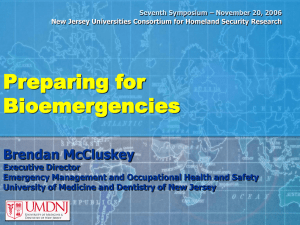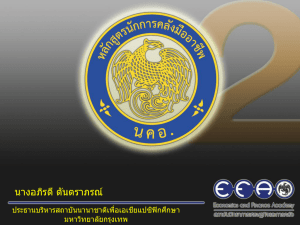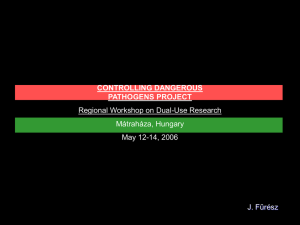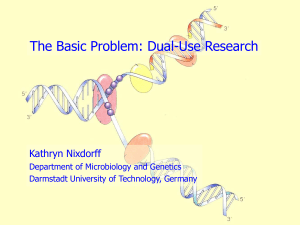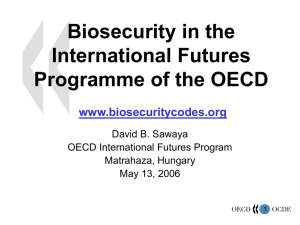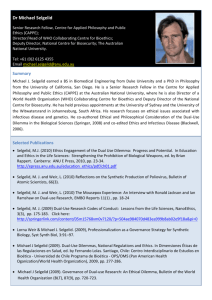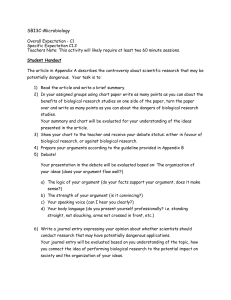hungary_workshop__report__may_2006.doc (53Kb)
advertisement
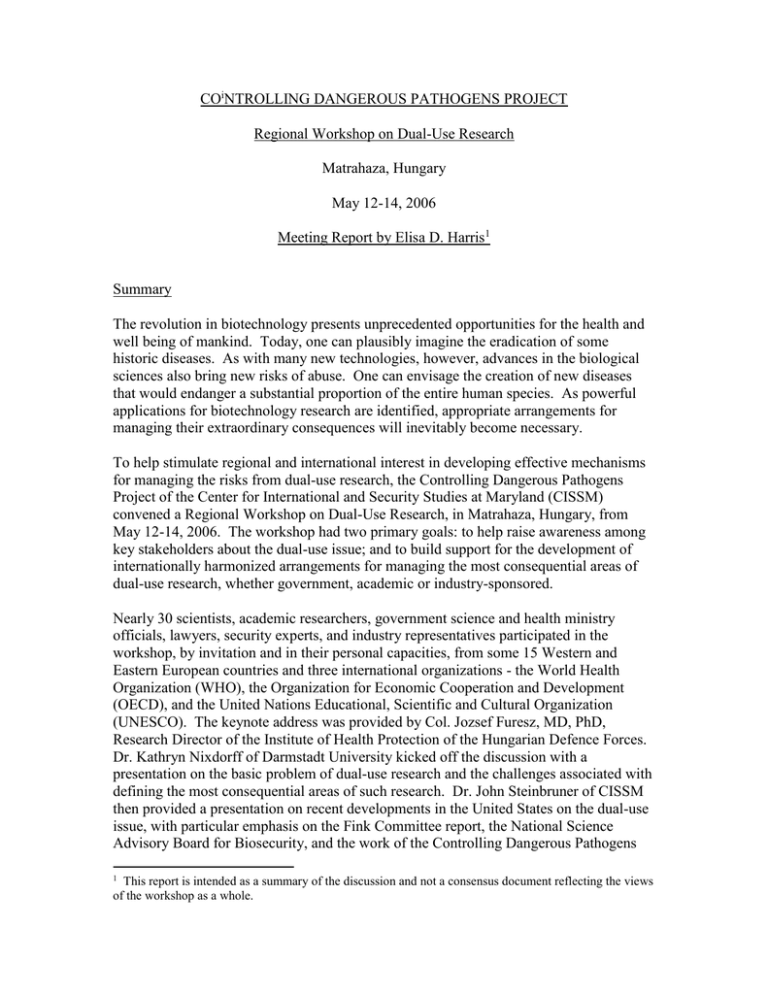
COiNTROLLING DANGEROUS PATHOGENS PROJECT Regional Workshop on Dual-Use Research Matrahaza, Hungary May 12-14, 2006 Meeting Report by Elisa D. Harris1 Summary The revolution in biotechnology presents unprecedented opportunities for the health and well being of mankind. Today, one can plausibly imagine the eradication of some historic diseases. As with many new technologies, however, advances in the biological sciences also bring new risks of abuse. One can envisage the creation of new diseases that would endanger a substantial proportion of the entire human species. As powerful applications for biotechnology research are identified, appropriate arrangements for managing their extraordinary consequences will inevitably become necessary. To help stimulate regional and international interest in developing effective mechanisms for managing the risks from dual-use research, the Controlling Dangerous Pathogens Project of the Center for International and Security Studies at Maryland (CISSM) convened a Regional Workshop on Dual-Use Research, in Matrahaza, Hungary, from May 12-14, 2006. The workshop had two primary goals: to help raise awareness among key stakeholders about the dual-use issue; and to build support for the development of internationally harmonized arrangements for managing the most consequential areas of dual-use research, whether government, academic or industry-sponsored. Nearly 30 scientists, academic researchers, government science and health ministry officials, lawyers, security experts, and industry representatives participated in the workshop, by invitation and in their personal capacities, from some 15 Western and Eastern European countries and three international organizations - the World Health Organization (WHO), the Organization for Economic Cooperation and Development (OECD), and the United Nations Educational, Scientific and Cultural Organization (UNESCO). The keynote address was provided by Col. Jozsef Furesz, MD, PhD, Research Director of the Institute of Health Protection of the Hungarian Defence Forces. Dr. Kathryn Nixdorff of Darmstadt University kicked off the discussion with a presentation on the basic problem of dual-use research and the challenges associated with defining the most consequential areas of such research. Dr. John Steinbruner of CISSM then provided a presentation on recent developments in the United States on the dual-use issue, with particular emphasis on the Fink Committee report, the National Science Advisory Board for Biosecurity, and the work of the Controlling Dangerous Pathogens 1 This report is intended as a summary of the discussion and not a consensus document reflecting the views of the workshop as a whole. Project. This was followed by a panel on regional and international developments related to dual-use research, with Mr. David Sawaya of the OECD, Ms. Simone Scholze of UNESCO and Dr. Karl Simpson, an industry consultant. Dr. Geoffrey Smith of the British Royal Society and Dr. Ottorino Cosivi of the WHO then gave presentations on the efforts of various international scientific and health organizations to help mitigate the risks from dual-use research. Finally, Dr. Filippa Corneliussen of the London School of Economics, Dr. Dominique Werner of the Spiez Laboratory, Dr. Caitriona McLeish of the University of Sussex, Dr. Vivienne Nathanson of the British Medical Association, and Dr. Nigel Silman of the UK Health Protection Agency at Porton Down considered various aspects of the dual-use issue as it relates to Europe specifically, including whether there are different perceptions of the threat from dual-use research both within Europe and between Europe and the United States, whether existing oversight arrangements in European countries are adequate, and whether there are legal and cultural differences that would have to be addressed as part of any effort to strengthen research oversight within Europe. There was broad agreement among workshop participants that, to be effective, any effort to prevent the misuse of biotechnology research must apply to all institutions engaged in relevant work, without exception. Strong arguments were made for codes of conduct for scientists, education and training programs, and independent peer review of prospective research projects to help address dual-use concerns, building on existing biosafety and other review processes. The importance of harmonizing such approaches regionally and internationally was also emphasized, given that relevant life sciences research is taking place in virtually every region of the world. Throughout the discussion, participants noted the importance of conducting biological research under conditions of transparency to assure that independent, broadly based scrutiny is brought to bear in a timely manner. Specific Issues Defining dangerous research: Workshop participants discussed the challenges associated with defining in advance what may pose dual-use risks in the future. This underscores the importance of creating a process that scientists, security experts and other stakeholders can use to engage with one another and respond to changes in science and technology that raise dual-use concerns. Threat perceptions: Workshop participants pointed out that there is a lack of agreement within the scientific community on the nature of the threat from dual-use research. Some believe that the threat is being exaggerated and that there is a need to promote greater understanding of the successes of science in order to put the risk from dual-use research in context. Others cite Harvard University Professor Matthew Meselson’s observation that every major scientific innovation ultimately has been exploited for military purposes and fear that the same will happen with advanced biotechnology research. Judgments within the scientific community currently differ on the degree of danger posed and on the feasibility of preventing it. Those differences will have to be narrowed if procedures for protection are to be developed. Effective protection almost certainly depends on achieving a workable scientific consensus. Policy responses: There was general agreement among workshop participants that no one approach will be sufficient to deal effectively with the dual-use issue. Policy responses are needed that establish responsibility both at the level of the individual scientist and at the governmental and intergovernmental level. These policies should address the problem of inadvertence as well as of deliberate malfeasance. They should help reduce the threat of legitimate scientists inadvertently initiating destructive applications of advanced research. They should also retard the efforts of those who might deliberately misuse biology for destructive purposes. Codes of conduct and education and training programs for scientists can help inform individual scientists of their ethical and legal responsibilities when conducting dual-use research. As such, they can help promote a culture of responsibility and heightened awareness among scientists about the dual-use issue. This is particularly important given the historic autonomy of life scientists. Universities can play an important role in this regard by requiring that students and faculty adhere to any relevant codes and by providing mandatory biosecurity courses. National and international laws and regulations can also help prevent destructive applications of advanced biotechnology research. Requirements for independent peer review of dual-use research can help identify potential benefits and risks, including means of mitigating risk. Independent scrutiny is the standard method of protecting against misjudgment or malfeasance in other matters of consequence such as the handling of money or dangerous nuclear materials. Provisions for licensing individuals and facilities engaged in dual-use research can help governments keep track of where consequential work is being carried out and ensure that it is being done consistent with existing biosafety and biosecurity standards. Facility inspections and penalties for breaches of the rules can help enforce compliance with dual-use requirements, as is being done in other areas of biological research involving animals or recombinant DNA. Participants agreed that policies to address the dual-use issue need to be balanced in order to avoid deterring scientists from continuing to engage in relevant research or undermining public support for cutting edge research. The example of plant biotechnology was cited, in which not all of the scientific potential has been realized because of over-emphasis of risk and what some believe to be over-regulation. Voluntary vs. mandatory measures: Workshop participants considered the utility of both voluntary and mandatory measures in helping address the dual-use issue. Some participants were optimistic about the potential impact of voluntary measures, citing as an example industry’s success in screening the blood supply for HIV. But others believe that scientists won’t regulate themselves unless they are legally obligated to do so. Binding legal obligations also establish bright lines so there is no ambiguity about what society expects of scientists conducting dual-use research. As such, they can be a form of protection, in that scientists that adhere to the rules can pursue their work confidently and without fear of prosecution. Professionalization of biology: Participants discussed a range of mechanisms for helping integrate the dual-use issue into the professional lives of life scientists. One possibility would be to add a requirement for adherence to all national and international laws and regulations on dual-use research to employment contracts, as is done in some countries for biosafety. Failure to comply would be a dismissible offense. Similar requirements could be established by funding bodies, both governmental and nongovernmental, as a condition of receiving a grant. Scientific journals could likewise refuse to publish manuscripts from individuals or facilities that do not adhere to agreed national and international rules or codes of conduct for dual-use research. Harmonization: Workshop participants generally agreed that efforts to manage the risks from dual-use research needed to be harmonized internationally, given the global scope of the life sciences research community. Globally harmonized rules would be of value in situations where individual scientists were being pressured to undertake work that might contravene international treaty obligations such as the Biological and Toxin Weapons Convention (BWC). They would also help ensure a level playing field for both academic and industrial researchers. Governments and scientists need to work together to develop and test any proposed rules. One model is the OECD’s efforts since 2001 to develop a harmonized international approach to the management and security of culture collections and other biological resources. Only laboratories that adhere to the agreed biosafety and biosecurity standards can be part of the biological resource centers network and get access to pathogens. Efforts to achieve a harmonized international approach to the dual-use issue would likely have to overcome differing perspectives on both the threat and possible policy responses. Within Europe, scientists generally see cutting edge research in terms of opportunities while the public sees potential risks. There are also differences between Europe and the U.S. -- with the former accepting the legitimacy of extra-national law and the latter highly resistant to subjecting its citizens to external legal requirements. European biotechnology companies are also more collegial and have a less adversarial relationship with government regulatory bodies than similar companies in the US. Finally, there are differences between developed and developing countries over whether biological threats should be addressed within or outside the context of the BWC. International organizations can help bridge these differences by providing a forum for the development of internationally agreed mechanisms for oversight of dual-use research. Such a mandate, for example, is embedded in the WHO Constitution, which articulates the reciprocal relationship between health and security by stating that “the health of all peoples is fundamental to the attainment of peace and security” [emphasis added] and calls upon the Organization “to act as the directing and co-coordinating authority on international health work.” In order for international organizations to fulfill this role, however, a strong and wide political commitment is required at both the national and international level. Incremental steps: Workshop participants discussed the need for both a vision of the ultimate goal and an incremental strategy to begin to manage the risks from dual-use research. The latter might include the development of codes of conduct for scientists, outlining basic ethical requirements; the adaptation of existing national regulations to address the dual-use issue; and the development of internationally agreed guidelines under WHO. Biodefense: Workshop participants generally agreed that biodefense research activities should be as open as possible and should not be exempt from oversight requirements. A number of countries already subject their biodefense research activities to independent peer review, often on an annual basis. There are also clear requirements for such programs to adhere to existing rules for oversight of recombinant DNA and animal research. Adding the dual-use issue to the oversight process was seen as something that was manageable and that could be made compatible with the needs of biodefense research. Industry: Workshop participants discussed the dual-use issue in relation to the biotechnology and pharmaceutical industries. It was noted that oversight is potentially. more complicated for larger companies, many of which leave biosafety to administrators familiar with the rules rather than bench-level scientists knowledgeable about the science. There are also proprietary issues associated with independent peer review. These could be dealt with through confidentiality agreements, which already are being used in industry as part of the peer review process for genetic modification work in the UK and other European countries. Industry would have an incentive to cooperate with an independent oversight process for dual-use research given its sensitivity to “reputational risk.” Publication restrictions: It was generally agreed by workshop participants that considering dual-use risks and possible dissemination restrictions only when the research was completed and a manuscript ready for publication was too late, given the range of other mechanisms available for sharing research results. Scientists share their results through presentations, abstracts, posters, and informal communication. The trend is toward greater transparency, as evidenced by the UK Wellecome Trust’s requirement for grantees to provide immediate on-line access to research results rather than wait for journal publication. Transparency: Workshop participants noted the importance of transparency in relation to dual-use research but agreed that absolute openness was not always possible. Public concerns about GMOs and animal testing preclude complete openness in plant biotechnology and animal research. There are also sensitivities about proprietary information in industry and about national security in the area of biodefense research. This may require the use of intermediary options, such as delaying the release of sensitive results until a patent has been obtained or a countermeasure is in hand. Another possibility would be to limit access to sensitive materials or methods to those with a need to know or who are a member in good standing of a particular professional society. Public trust: Participants discussed the lack of public confidence in the scientific community. The Asilomar Conference in the U.S., which led in the 1970s to the development of guidelines for oversight of dual-use research, included only scientists and did not permit other stakeholders to be involved. Efforts to develop biosecurity rules for dual-use research must be more inclusive and include other stakeholders, including public representatives. The rules themselves must result in a process that provides reassurance to the public that risks are being considered and appropriately addressed. This is demonstrated by the different attitudes to genetically modified plants in the US and Europe. Adaptation of existing review processes: Workshop participants generally agreed that existing institutions and processes for ensuring the safety of recombinant DNA, animal, human subject and other life sciences research can be adapted to take on the dual-use issue. Much of the infrastructure already exists at the local and national levels in many European countries and the U.S. Additional expertise would be needed on review bodies to consider dual-use risks and additional resources would be needed to support this mission and strengthening of the oversight bodies more generally. The operating procedures of the existing review bodies would also have to be re-examined to ensure that the system is capable of protecting national security and proprietary information. This may require some adaptation of the existing concept of local review bodies such as Institutional Biosafety Committees, which are expected to operate in a completely open fashion. Regulations for dual-use oversight could be adopted at the national level to guide these local review bodies. Regional considerations: Workshop participants noted that there are differences in how various European countries approach the issue of GMOs. These differences are often politically based rather than technical. Linguistic, cultural and legal differences within Europe will also have an impact on any effort to develop and implement oversight arrangements for dual-use research within Europe. The European CDC, which was established in Stockholm in 2004, could play a useful role in helping harmonize dual-use oversight requirements within Europe. Many European countries already follow WHO and European Union biosafety guidelines, although there are likely differences in actual implementation.
